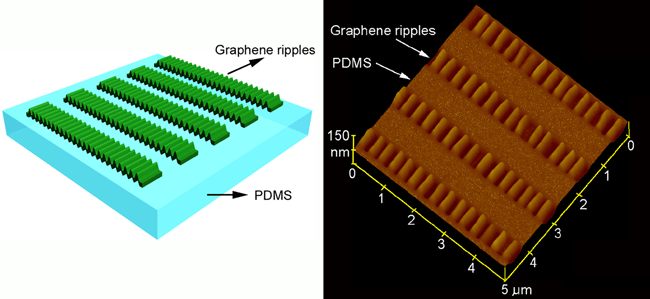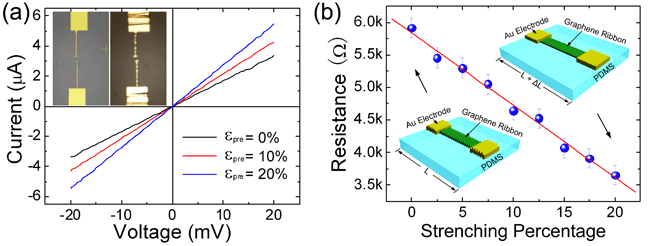Graphene, a two-dimensional carbon sheet, is a potential material for flexible electronics due to its flexibility, optical transparency, and electrical conductivity. But graphene is also a very rigid material, thus the mismatch of the stiffness between graphene and its elastic supports could lead to sliding or even fracture for graphene over its supports when applying a high level of tensile strain to them.
Guangyu Zhang, a professor of physics at Institute of Physics of CAS, and his research group provides a fresh solution for this challenge. Their results, published in the March. 31 issue of the ACS Nano (DOI: 10.1021/nn103523t), demonstrate that one can fold graphene to form supper elastic ripples on elastic substrates with very regular periodicities (see Figure 1). The fabrication process for graphene ripples is a little bit complicated. The tricky part is to use the pre-strained elastic supports to receive the transferred graphene, thus the ripples will form spontaneously by self-assembly mechanism.
These three-dimensional graphene ripples with well controlled morphologies are interesting not only in terms of their fancy structures but also of their potentials for flexible electronics. In their article, they exhibited a use of such supper elastic graphene ripples for high level strain sensors (see Figure 2). By connecting two electrodes to the ends of a single graphene ribbon ripple, they measured the resistance changes upon different strain conditions. Surprisingly, the overall resistance shows a linear relationship with applied strain; thus, one could use such devices for strain sensors for detection of high level strain (>30%). Despite of the use for strain sensors, these graphene ripple structures could have improved performance for graphene touch screen, supper flexible electrodes and sensor devices, etc.
This work was supported by NSFC and National 973 projects.
 |
| Figure 1 Supper elastic graphene ripples formed on PDMS substrates。Left, schematic drawing, and Right, AFM image of the graphene ripples. |
 |
| Figure 2 Graphene ripples for strain sensors. (a) I-V curve of a typical graphene ripple device. (b) Resistance dependence of this device upon different applied tensile strains. The strain sensor gauge factor is -2。 |



